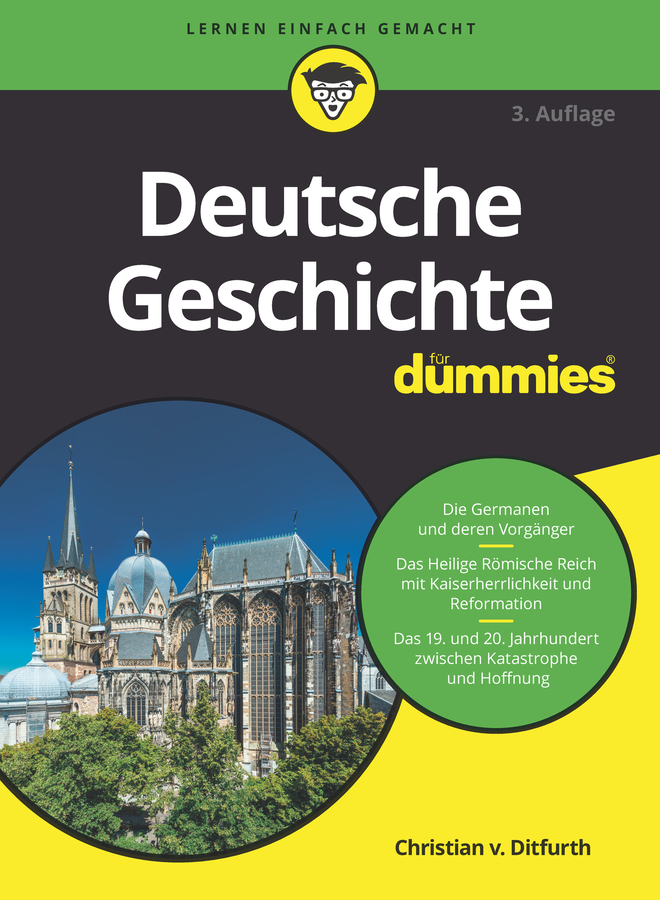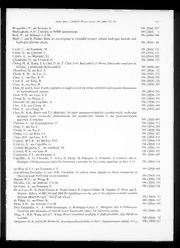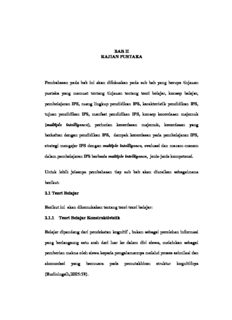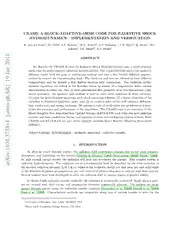
Crash: A Block-Adaptive-Mesh Code for Radiative Shock Hydrodynamics - Implementation and Verification PDF
Preview Crash: A Block-Adaptive-Mesh Code for Radiative Shock Hydrodynamics - Implementation and Verification
CRASH: A BLOCK-ADAPTIVE-MESH CODE FOR RADIATIVE SHOCK HYDRODYNAMICS – IMPLEMENTATION AND VERIFICATION B. van der Holst1, G. T´oth1, I.V. Sokolov1, K.G. Powell1, J.P. Holloway1, E.S. Myra1, Q. Stout1, M.L. Adams2, J.E. Morel2, R.P. Drake1 1 1 ABSTRACT 0 2 WedescribetheCRASH(CenterforRadiativeShockHydrodynamics)code,ablockadaptive n a meshcode formulti-materialradiationhydrodynamics. The implementationsolvesthe radiation J diffusion model with the gray or multigroup method and uses a flux limited diffusion approxi- 9 mation to recover the free-streaming limit. The electrons and ions are allowed to have different 1 temperatures and we include a flux limited electron heat conduction. The radiation hydro- ] dynamic equations are solved in the Eulerian frame by means of a conservative finite volume R discretizationineither one,two,orthree-dimensionalslabgeometryorintwo-dimensionalcylin- S drical symmetry. An operator split method is used to solve these equations in three substeps: . h (1)solvethehydrodynamicequationswithshock-capturingschemes,(2)alinearadvectionofthe p radiation in frequency-logarithm space, and (3) an implicit solve of the stiff radiation diffusion, - o heatconduction,andenergyexchange. Wepresentasuiteofverificationtestproblemstodemon- r t strate the accuracy and performance of the algorithms. The CRASH code is an extension of the s a Block-AdaptiveTreeSolarwindRoe UpwindScheme(BATS-R-US) codewiththis new radiation [ transferand heatconduction libraryandequation-of-stateand multigroupopacitysolvers. Both 1 CRASH and BATS-R-US are part of the publicly available Space Weather Modeling Framework v (SWMF). 8 5 7 Subject headings: hydrodynamics – methods: numerical – radiative transfer 3 . 1 0 1. INTRODUCTION 1 1 : As photons travel through matter, the radiation field experiences changes due to net total emission, v i absorption, and scattering, see for instance Mihalas & Mihalas (1984); Pomraming (2005); Drake (2006). X At high enough energy density the radiation will heat and accelerate the plasma. This coupled system is r radiation hydrodynamics. The radiation can at a fundamental level be described by the time evolution of a the spectralradiationintensity I (r,t,n,ν), which is the radiationenergyper unit area,per unit solidangle ν inthe directionofphotonpropagationn,perunitintervalofphotonfrequencyν,andperunittime interval. Several method have been developed to solve the radiation field in various degree of physics fidelity. In Monte Carlo radiative transfer methods, the radiation is statistically evaluated. Small photon pack- ets are created with their energy and propagation direction statistically selected. The packets are prop- agated through matter using the radiation transfer equation (Nayakshin et al. 2009; Maselli et al. 2009; Baek et al. 2009). Characteristic methods use integration along rays of various lengths to solve for the 1UniversityofMichigan,AnnArbor,MI48109, USA 2TexasA&MUniversity,CollegeStation, TX,USA – 2 – angular structure of the radiation transport. A recent conservative, causal ray-tracing method was devel- oped and combined with a short characteristic ray-tracing for the transfer calculations of ionizing radiation (Mellema et al. 2006). Solar surface magneto-convection simulations are increasingly realistic and use a three-dimensional,non-gray,approximatelocalthermodynamicequilibrium(LTE),radiativetransferforthe heating and cooling of plasma. These simulations are typically formulated for four frequency bins in the radiative transport equation (Vo¨gler et al. 2005; Stein et al. 2007; Mart´ınez-Sykoraet al. 2009). For some applications, simplifications to the radiation transfer can be made by calculating moments of the radiation intensity over the solid angle Ω. The spectral radiation energy and the spectral radiation energy flux are defined by the 0th and 1st moments as 1 E (r,t,ν)= I (r,t,n,ν)dΩ, F (r,t,ν)= nI (r,t,n,ν)dΩ. (1) ν ν ν ν c Z4π Z4π In addition, the spectral radiation pressure tensor P is defined by the second moment ν 1 P (r,t,ν)= nnI (r,t,n,ν)dΩ. (2) ν ν c Z4π A whole class of radiation transfer models are based on solving the corresponding radiation moment equa- tions,usingaclosurerelationbetweenthespectralpressuretensorandthespectralintensity(Mihalas & Mihalas 1984; Pomraming 2005; Drake 2006). A radiation-hydrodynamics code based on variable Eddington tensor (VET) methods (Stone et al. 1992) canstill capturethe angularstructureofthe radiationfieldby relatingthe spectralradiationpressure tensor to the spectral radiation intensity and the method is applicable for both the optically thin and thick regime. OpticallythinversionsoftheVETmethodhavebeenusedinthecontextofcosmologicalreionization (Petkova & Springel 2009). Further simplificationassumesthatthe radiationpressureisisotropicandproportionalto the radiation energy. This is the diffusion approximation. Several codes have been developed using this approximation. HYDRA (Marinak 2001) is an arbitrary Lagrange Eulerian code for 2D and 3D radiation hydrodynamics. The radiationtransfer modelis basedupon either flux limited multigrouporimplicit Monte Carloradiation transport. The Eulerian code RAGE (Gittings et al. 2008) uses a cell-based adaptive mesh refinement to achieve resolved radiative hydrodynamic flows. HYADES (Larsen & Lane 1994) solve the radiation hydro- dynamic equationsonaLagrangianmesh, while CALE(Barton 1985)canuse eithera fixedEulerianmesh, an embedded Lagrangian mesh, or a partially embedded, partially remapped mesh. Our newly developed radiation-hydrodynamic solver uses an Eulerian grid together with a block-based adaptive mesh refinement strategy. We limit the discussion of the radiation hydrodynamics implementation in CRASH to plasmas in the absence of magnetic field. Most of the description in this paper can, however,easily be extended to magne- tohydrodynamic(MHD) plasmasaswell. Indeed,sincethe CRASHcodeisessentiallythemagnetohydrody- namicBATS-R-UScode(Powell et al. 1999;Toth et al. 2010)extendedwithlibrariescontainingradiation transport, equation-of-state (EOS), and opacity solvers, the implementation for the coupling between the radiation field and MHD plasmas is readily available. The CRASH code uses the recently developed block adaptivetreelibrary(BATL,Toth et al. (2010)). Herewewillfocusontheradiationimplementation. Both theCRASHandBATS-R-UScodesarepubliclyavailableaspartoftheSpaceWeatherModelingFramework (SWMF, Toth et al. (2005)) or can be used as stand-alone codes. Inthefollowing,Section2introducestheradiationhydrodynamicequationsformulti-materialplasmas, in a form general enough to apply at high energy density. Section 3 describes the numerical algorithms – 3 – to solve these equations. Next, in Section 4 verification tests, are presented for radiation and electron heat conductiononnon-uniformmeshesin1D,2D,and3Dslabgeometryandinaxiallysymmetric(rz)geometry. We alsoshowafullsystemmulti-materialradiationhydrodynamicsimulationonanadaptivelyrefinedmesh and demonstrate good scaling up to 1000 processors. The paper is summarized in Section 5. 2. EQUATIONS OF RADIATION HYDRODYNAMICS IN DENSE PLASMAS The equations of radiation hydrodynamics describe the time evolution of both matter and radiation. Fortheapplicationsthatsupportedtheworkreportedhere,thecodemustbeabletomodelmatterasahigh energydensityplasmathatisinLTEsothatthepopulationofallatomicandionstatescanbeobtainedfrom statistical physics (see for instance Landau & Lifshitz (1980)). We allow for multiple materials throughout the spatial domain of interest, but restrict the analysis to plasma flows that are far from relativistic. The materials can be heated to sufficiently high temperatures so that they can ionize and create free electrons, introducing the need for a time evolution equation for the electron energy density. The electrons transfer heat by thermal heat conduction and emit and absorb photon radiation. The radiation model discussed in this paper is non-equilibrium diffusion, in which the electron and radiation temperature can be different. We approximate the radiation transfer with a gray or multigroup flux limited diffusion (FLD). This model is also of interest for application to a number of astrophysical problems. In the following subsections, we will describe the radiative transfer equations for the evolution of the multigroupradiationenergydensities(Section2.1)intheFLDapproximation(Section2.5). Thecouplingof the radiation field to the two species hydrodynamic equations of electrons and ions are discussed in Section 2.2. In Section 2.3, the method for tracking the different materials is treated, while the lookup tables used for of the EOS and opacities are mentioned in Section 2.4. 2.1. Radiation Transport Inthis section, wewillbuild upthe formofthe radiationtransportinthe multigroupdiffusionapproxi- mation that is used for the implementation in the CRASH code. The spectralpressuretensor, equation(2), is often approximated in the form (Mihalas & Mihalas 1984) P (r,t,ν)=E T , (3) ν ν ν where 1 1 F F T (r,t,ν)= (1 χ )I+ (3χ 1) ν ν, (4) ν 2 − ν 2 ν − F 2 ν | | is the spectral Eddington tensor, χ is the Eddington factor, and I is the identity matrix. The second term ν on the right hand side is a dyad constructed from the direction of the spectral radiation flux. The pressure tensor can be used to arrive at a time evolution equation for the solid angle integrated spectral radiation energy (Buchler 1983) ∂E ∂ ν + (E u) ν (P : u)=diffusion+emission absorption, (5) ν ν ∂t ∇· − ∂ν ∇ − which contains the plasma velocity u of the background plasma. Here the colon denotes the contraction of the two tensors P and u. The processes described by the symbolic terms on the right hand side of ν ∇ equation (5) will be described below. – 4 – Setting the Eddington factor χ = 1/3 corresponds to the radiation diffusion model. In this case the ν radiation is assumed to be effectively isotropic and the spectral radiation pressure can be described by the scalar 1 p = E =(γ 1)E , (6) ν ν r ν 3 − where we have introduced the adiabatic index of the radiation field, which in this case has the relativistic value γ =4/3. The time evolution for the spectral energy density can then be simplified to r ∂E ∂E ν + (E u) (γ 1)( u)ν ν =diffusion+emission absorption. (7) ν r ∂t ∇· − − ∇· ∂ν − The second and third terms on the left hand side of equation (7) express the change in the spectral energy density due to the advection and compression of the background plasma, which moves with the velocity u, as well as the frequency shift due to compression. In the free-streaming limit where the radiation hardly interacts with the matter, χ will approach one. In this paper we will keep χ =1/3 and at the same time ν ν use a flux limited diffusion for the free-streaming regime whenever needed (see Section 2.5). The set of equations for the spectralenergy density (7) still consists of an infinite amount of equations, one for each frequency. A finite set of governing equations to describe the radiation transport in the multi- group diffusion approximation is obtained when we choose a set of frequency groups. Here we enumerate groups with the index, g = 1,...,G. The interval of the photon frequencies, relating to the gth group is denoted as [ν ,ν ]. A discrete set of group energy densities, E , is introduced in terms of the g−1/2 g+1/2 g integrals of the spectral energy density of the frequency group interval: νg+1/2 E = E dν. (8) g ν Zνg−1/2 Now we can integrate equation (7) to arrive at the desired set of the multigroup equations: ∂Eg + (E u)+(γ 1)E u (γ 1)( u) νg+1/2 ∂(νEν)dν g r g r ∂t ∇· − ∇· − − ∇· ∂ν Zνg−1/2 νg+1/2 = (diffusion+emission absorption)dν. (9) − Zνg−1/2 The fourth term on the left hand side is a frequency shift due to the plasma compression. This term is essentially a conservative advection along the frequency axis. In the context of the multi-group radiation diffusion, a discussion about the stimulated emission is not lessimportantthanLTE.Excellentaccountsonthestimulatedemissionexistintheliterature,seeforinstance Zel’dovich & Raizer (2002). Here,wemerelysumarizehowthe stimulatedemissionmodifiesthe absorption opacity κa obtained from, e.g., opacity tables. This is important when dealing with externally supplied ν opacity tables, since the CRASH code assumes that the absorption opacities are corrected. Integrating the total absorption and emission over all directions and summing up the two polarizations of the photons, the following expression can be derived for the emission and absorption emission absorption=cκa′(B E ), (10) − ν ν − ν where the effective absorption coefficient, κa′, is introduced to account for the correction due to stimulated ν emission: ε κa′ =κa 1 exp , (11) ν ν − −k T (cid:18) (cid:20) B e(cid:21)(cid:19) – 5 – in which ε = hν is the photon energy, k is the Boltzmann constant, and T is the electron temperature. B e We also introduced the spectral energy density distribution of the black body radiation (the Planckian) 8π ε3 B = . (12) ν h3c3exp[ε/(k T )] 1 B e − The total energy density in the Planck spectrum equals B = ∞dνB =aT4, where a=8π5k4/(15h3c3) is 0 ν e B the radiation constant. R WeusethestandarddefinitionofthegroupPlanckmeanopacityκ andgroupRosselandmeanopacity Pg κ (Mihalas & Mihalas 1984) Rg κ = ννgg−+11//22dνκaν′Bν, κ = ∂∂BTeg , B = νg+1/2dνB (13) Pg R Bg Rg ννgg−+11//22dνκ1tν ∂∂BTeν g Zνg−1/2 ν R in which κt is the spectral total opacity. The right hand side of equation (9) can now be written as (see for ν instance Mihalas & Mihalas (1984); Pomraming (2005)) ∂Eg + (E u)+(γ 1)E u (γ 1) u νg+1/2 ∂(νEν)dν g r g r ∂t ∇· − ∇· − − ∇· ∂ν Zνg−1/2 = (D E )+σ (B E ), (14) g g g g g ∇· ∇ − whereD =c/(3κ )istheradiationdiffusioncoefficientforradiationgroupg. Theabsorptionandemission g Rg uses the coefficient σ = cκ . These group mean opacities are either supplied by lookup tables or by an g Pg opacity solver. Inasinglegroupapproximation(graydiffusion),thespectralenergydensityisintegratedoverallphoton frequencies and the total radiation energy density is obtained by ∞ E (r,t)= E dν. (15) r ν Z0 This amounts to summing up all groups E = E . The gray radiation diffusion equation can be derived r g g as (see for instance Mihalas & Mihalas (1984); Pomraming (2005); Drake (2006)) P ∂E r + (E u)+(γ 1)E u= (D E )+σ (B E ), (16) r r r r r r r ∂t ∇· − ∇· ∇· ∇ − where the diffusion coefficient D is now defined by the single group Rosseland mean opacity κ as D = r R r c/(3κ ), and the absorptioncoefficent σ is defined in terms of the single groupPlanck mean opacity κ as R r P σ =cκ . r P 2.2. Hydrodynamics In the CRASH code, a single fluid descriptionis used, so thatall ofthe atomic andionic species aswell as the electrons move with the same bulk velocity u. The conservation of mass ∂ρ + (ρu)=0, (17) ∂t ∇· – 6 – providesthe time evolutionofthe massdensity ρ ofallthe materialsin the simulation. The plasma velocity is obtained from the conservation of momentum ∂ρu + [ρuu+I(p+p )]=0. (18) r ∂t ∇· The total plasma pressure is the sum of the ion and electron pressures: p = p + p . The net force of i e the radiation on the plasma is given by the gradient of the total radiation pressure p , where the total r −∇ radiation pressure is obtained from the group radiation energies: p =(γ 1) E . r r g − In a high density plasma, the electrons are very strongly coupled to the iPons by collisions. However, for higher temperatures, the electrons and ions get increasingly decoupled. At a shock front, where ions are preferentially heated by the shock wave, the electrons and ions are no longer in temperature equilibrium. Ion energy is transfered to the electrons by collisions, while the electrons will in turn radiate energy. We therefore solve separate equations for the ion/atomic internal energy density E and the electron internal i energy density E : e ∂E i + (E u)+p u=σ (T T ), (19) i i ie e i ∂t ∇· ∇· − G ∂E e + (E u)+p u= (C T )+σ (T T )+ σ (E B ). (20) e e e e ie i e g g g ∂t ∇· ∇· ∇· ∇ − − g=1 X The coupling coefficient σ = n k /τ in the collisional energy exchange between the electrons and ions ie a B ie dependsontherelaxationtimeτ (T ,n ,m)andtheatomicnumberdensityn . Theenergytransferdepends ie e a a also on the difference between the ion temperature T and the electron temperature T . In equation (20), i e we have included the electron thermal heat conduction with conductivity C (T ,n ,m). Since the electrons e e a are the species that are responsible for the radiationabsorption and emission, the energy exchange between the electrons and the radiation groups is added to equation (20). For the developmentof the numericalschemes in Section 3 we will use an equationfor the conservation of the total energy density ρu2 G e= +E +E + E , (21) i e g 2 g=1 X instead of the equation for the ion internal energy (19). This is especially important in regions of the computational domain where hydrodynamic shocks can occur, so that we can recover the correct jump conditions. The conservation of the total energy can be derived from equations (14) and (17)–(20) as G ∂e + [(e+p+p )u]= (C T )+ (D E ). (22) r e e g g ∂t ∇· ∇· ∇ ∇· ∇ g=1 X Thefrequencyshiftterminequation(14)duetotheplasmacompressiondoesnotshowupintheconservation ofthetotalenergyifweuseenergyconservingboundaryconditionsattheendpointsofthefrequencydomain, i.e. atν =0andν = in the analyticaldescriptionoratthe end pointsofthe numericallytruncatedfinite ∞ domain. 2.3. Level Sets and Material Identification In many of the CRASH applications, we need a procedure to distinguish between different materials. Weassumethatthematerialsdonotmix,butdifferfromeachotherbytheirpropertiessuchastheequation – 7 – of state and opacities. If we use M different materials, then we can define for each material m = 1,...,M the level set function d (r,t) that is initially set to zero at the material interface, while positive inside the m material region and negative outside. Generally, we use a smooth and signed distance function in the intial state. At later times, the location of material m is obtained by means of a simple advection equation ∂d m + (d u)=d u. (23) m m ∂t ∇· ∇· For any given point in space and time, we can determine what the material is, since analytically only one of the level set functions d can be positive at any given point. Numerical errors will create regions where m this is not true. In practice we take the largest d . This is a simple approximation, we may explore more m sophisticatedapproachesinthe future. The number ofmateriallevelsM canbe configuredat compile time. 2.4. Equation of State and Opacities We haveimplementedEOSsolversandacode to calculatethe frequencyaveragedgroupopacities. The implemention will be reported elsewhere, but mention that in the EOS and opacity solver the temperature is assumed to be well below the relativistic values: T 105eV. The non-relativistic speed of motion is also ≪ assumed while simplifying the radiation transport equation and to neglect the relativistic corrections for opacities. In this paper, we will assume that all necessary quantities are calculated and stored in lookup tables. Our EOS solver assumes that the corrections associated with ionization, excitation, and Coulomb interactions of the partially ionized ion-electron plasma are all added to the energy of the electron gas and to the electron pressure. This is possible since those corrections are controlled by the electron temperature. Theioninternalenergydensity,ionpressure,andionspecific heatinanisochoricprocessperunitofvolume are simply p ∂E n k i i a B p =n k T , E = , C = = , (24) i a B i i Vi γ 1 ∂T γ 1 − (cid:18) i(cid:19)ρ − which are due to the contributions due to ion translational motions for which γ =5/3. The relationsamongthe electroninternalenergydensity,pressure,density,andtemperature areknown astheEOS.Tosolvetheserelationsisusuallycomplexandtimeconsuming. Wethereforestoretheserelations in invertible lookup tables. For each material m, our EOS tables have the logarithmic lookup arguments (logT ,logn ). The list of quantities stored in these tables is indicated in Table 1. These lookup tables are e a populated with quantities that are needed for both single temperature and two temperature simulations. For two-temperature plasma simulations, we will need p , E , the electron specific heat C , the electron e e Ve speed of sound gamma γ . For convenience we added the total pressure p = p +p , total internal energy Se e i densityE =E +E ,singletemperaturespecificheatC ,andthesingletemperaturespeedofsoundgamma i e V γ , which can be used in single temperature simulations. We use high enough table resolutions so that it S is sufficient to use a bilinear interpolation in the lookup arguments. If p or E (or p and E in single e e temperature mode) are known on entry of the lookup instead of T , we do a binary search in the table to e find the appropriate electron temperature. The latter only works as long as the necessary thermodynamic derivatives are sign definite, i.e. the table is invertible. Other thermodynamic quantities that are needed, but not stored in these lookup tables, can be derived. For example, the electron density can be obtained from the mean ionization n =n Z. e a In addition, we have lookup tables for the averaged multigroup opacities. These tables are either constructedinternallyforagivenfrequencyrange,numberofgroups,andtheselectedmaterials,orexternally – 8 – supplied. For any material m, the logarithmic lookup arguments are (logρ,logT ). The stored quantities, e see Table 2, are the specific Rosseland mean opacity κ /ρ and the specific Planck mean opacity κ /ρ for Rg Pg allgroupsg =1,...,G thatareusedduring a simulation. The Planckopacitiesareassumedto be corrected forthestimulatedemission,asdiscussedinSection2.1. Thegroupsarealwaysassumedtobelogarithmically distributed in the frequency space. 2.5. Flux Limited Diffusion Radiation diffusion theory can transport energy too fast in the optically thin free streaming limit. In the diffusion limit, the radiation diffusion flux for each group follows Fick’s law F = D E , where the g g g − ∇ diffusion coefficient D depends on the Rosseland mean opacity κ for the group g via D = c/(3κ ). g Rg g Rg This flux is howevernot bounded. In the optically thin free-streaming limit, the magnitude of the radiation flux can be at most cE in order to maintain causality. Various flux limiters exist in the literature, see for g instance Minerbo (1978); Lund & Wilson (1980); Levermore & Pomraming (1981), that ensure that the diffusion flux is limited by this free streaming flux. We implemented the so-called square-root flux limiter to obtain the correct progation speed in the optically thin regime (Morel 2000). For this flux limiter, the diffusion coefficient is rewritten as c D = . (25) g (3κ )2+ |∇Eg|2 Rg E2 g q In the limit that the radiation length scale L = E / E is large, the diffusive limit is recovered. For a R g g |∇ | small radiation length scale, D =cE / E and the radiation propagates with the speed of light. g g g | | |∇ | Similarly,weimplementedtheoptiontolimittheelectronthermalheatflux(seeDrake (2006)formore detailsonelectronfluxlimiters). TheclassicalSpitzer-Harmformulaforthecollisionalelectronconductivity is proportional to T5/2/Z2, where Z2 is the mean square ionization of the used material. The collisional e model is only valid when the temperature scale length L = T / T is much larger than the collisional T e e |∇ | mean free path of the electrons λ . When the temperature scale length is only a few λ or smaller, mfp mfp this description breaks down. This may for instance happen in laser-irradiated plasmas. One could in that casefindtheheatfluxfromsolvingtheFokker-Planckequationfortheelectrons,butthisiscomputationally expensive. Instead, we use a simplified model to limit the electronheat flux. A free-streaming heat flux can be defined as the thermal energy density in the plasma transported at some characteristic thermal velocity: F = n k T v , where v = k T /m . For practical applications, the maximum heat transport is FS e B e th th B e e usually only a fraction of this free-streaming flux: F = (fF / T ) Te, where f is the so-called flux p − FS |∇ e| ∇ limiter. This heat flux model is the threshold model and is also used in other radhydro packages, such as HYADES (Larsen & Lane 1994). The flux-limited heat flux can now be defined as fF F= min C , FS T . (26) e e − T ∇ (cid:18) |∇ e|(cid:19) The flux limiter f is an input parameter and can be tuned to let the simulated results better fit reality. 3. THE NUMERICAL METHOD In this section, we describe the discretization of the set of multi-material, radiation hydrodynamics equations for the density (17), momentum (18), total energy (22), electron internal energies (20), radiation – 9 – groupenergy(14),andmateriallevelsetfunctions(23). Theequationsaretimeintegratedusinganoperator split method to solve the equations in substeps. Formally, we may write this system as ∂U =R (U)+R (U)+R (U), (27) hydro frequency diffusion ∂t where U is the vectorof state variables. We havesplit the righthand sides of the equations into three parts andtimeadvancetheequationswithanoperatorsplittingmethodinthefollowingorder: (1)Therighthand side R describes the advection and pressure contributions (Section 3.1). This part is essentially the hydro ideal hydrodynamic equations augmented with the advection and compression of the radiation energy, the electron internal energy, and the material level sets. (2) The right hand side R is the advection frequency of the radiation field in frequency space (Section 3.2). (3) The right hand side R takes care of diffusion the diffusion and energy exchange terms, which we will solve with an implicit scheme (Section 3.3). The operator splitting is not unique. Instead of splitting the hydrodynamic advection operator and the extra advance operator for the frequency advection, one may attempt to discretize the frequency advection flux as anextra flux for the controlvolumeof the four-dimensional(x,y,z,ν) space. However,since the CRASH code is built around the existing BATS-R-US code in 1D, 2D, and 3D, we opted for splitting the frequency advection from the hydro update. The boundary conditions are treated in Section 3.4. 3.1. Hydro Solve Inthefirststepoftheoperatorsplitting,weupdatethehydrodynamicequationsincludingtheadvection andcompressionoftheradiationenergydensity,electroninternalenergydensityandthelevelsets. Wehave implemented two variants to solve the hydrodynamic equations: (1) using conservation of the total energy (Section 3.1.1) and (2) a non-conservative pressure formulation (Section 3.1.2). We can combine the two discretizations in a hybrid manner a simulation. 3.1.1. Conservative We have implemented several hydrodynamic shock-capturing schemes in the CRASH code: the HLLE scheme(Harten et al. 1983;Einfeldt et al. 1991),theRusanovscheme(Yee 1989),andaGodunovscheme (Godunov 1959)withanexactRiemannsolver. Inthissection,wewillexplainhowwegeneralizedtheHLLE schemeforoursystemofequationsthatincludesradiation,levelsets,andanEOS.Theotherhydrodynamic schemes can be generalized in a similar fashion. Typical hydrodynamic solvers in the literature assume constant γ. Our problem is to generalize the constant γ hydro solvers for the case of spatially varying polytropic index, γ , due to ionization, excitation e andCoulombinteractions. Amethodthatisapplicabletoalltheaforementioned,constantγ,hydrodynamic shock-capturing schemes is to split the electron internal energy E density as the sum of an ideal (transla- e tional) energy part p /(γ 1) and an extra internal energy density E . Similarly, we can define an ideal e X − total energy density ρu2 p +p G i e e = + + E , (28) I g 2 γ 1 − g=1 X whichis relatedto the totalenergydensity by e=e +E . We willtime advance p with the idealelectron I X e pressureequationandE byaconservativeadvectionequation,andthenapplyacorrectionstepasdescribed X below. – 10 – The time update with the operator R solves the following equations: hydro ∂ρ + (ρu)=0, (29) ∂t ∇· ∂ρu + [ρuu+I(p+p )]=0, (30) r ∂t ∇· ∂e I + [(e +p+p )u]=0, (31) I r ∂t ∇· 1 ∂p 1 e + (p u)+p u=0, (32) e e γ 1 ∂t γ 1∇· ∇· − − ∂E X + [E u]=0, (33) X ∂t ∇· ∂E g + (E u)+(γ 1)E u=0, (34) g r g ∂t ∇· − ∇· ∂d m + (d u) d u=0, (35) m m ∂t ∇· − ∇· where the frequency advection, diffusion, and energy exchange terms are ommitted in this first operator step. After each time advance from time tn to time tn+1, we have to correct e, e , p , and E . We denote I e X the uncorrectedvariables with a superscript , then we recoverat time level n+1 the true electron internal ∗ energy En+1 and the true total energy density en+1 by e p∗ En+1 = e +E∗ , (36) e γ 1 X − en+1 = e∗+E∗. (37) I X Since both e and E follow a conservation law, the total energy density e is also conserved. The true I X electron pressure is recovered from the updated electron internal energy and mass density by means of the EOS: pne+1 =pEOS(ρn+1,Een+1,m), (38) wherethe functionpEOS canbe either a calculatedEOSor anEOSlookuptable formaterialm, determined bythe levelsetfunctionsdn+1 (Section2.3). TheextrainternalenergyE isresetasthe differencebetween m X the true electron internal energy and the ideal electron internal energy for γ =5/3: pn+1 En+1 =En+1 e . (39) X e − γ 1 − This is postive because the EOS state pEOS satisfies Ee pe/(γ 1) 0 at all times. The ideal part of the − − ≥ total energy density at time level n+1 can now be updated as en+1 =en+1 En+1. (40) I − X We have now recovereden+1, e n+1, pn+1, and En+1 at time tn+1. I e X We time advanced the hydrodynamic equations to the time level with a shock-capturing scheme with ∗ a constant γ =5/3. For an ideal EOS, the speed of sound of the equations (29)–(34) can be derived as γ(p +p )+γ p i e r r c = , (41) s s ρ
The list of books you might like

The 48 Laws of Power

The Spanish Love Deception

What Happened to You?

As Good as Dead
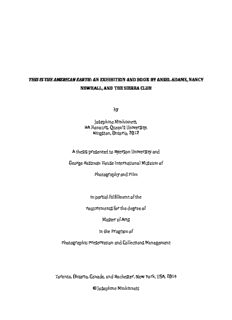
THIS IS THE AMERICAN EARTH

DTIC ADA448671: Religion and the Military: A Growing Ethical Dilemma
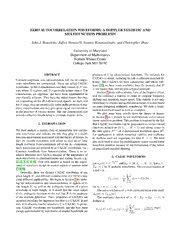
DTIC ADA476425: Zero Autocorrelation Waveforms: A Doppler Statistic and Multifunction Problems
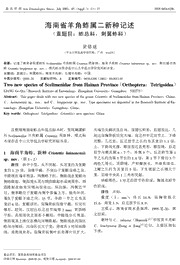
Two new species of Scelimenidae from Hainan Province (Orthoptera:Tetrigoidea)
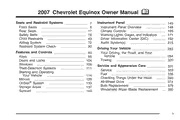
2007 Chevrolet Equinox Owner Manual

Cities in South Asia

Secret of the Ring Muscles

Sociological Forum 2006: Vol 21 Index
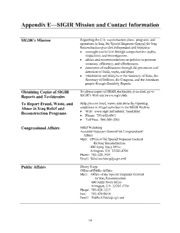
DTIC ADA545428: Department of State Contract to Study the Iraq Reconstruction Management System

TS 129 198-11 - V5.8.0 - Universal Mobile Telecommunications System (UMTS); Open Service Access (OSA) Application Programming Interface (API); Part 11: Account management Service Capability Feature (SCF) (3GPP TS 29.198-11 version 5.8.0 Release 5)
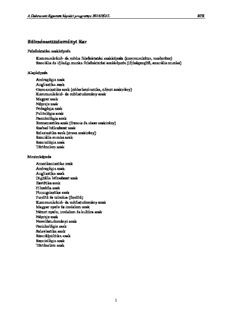
Bölcsészettudományi Kar
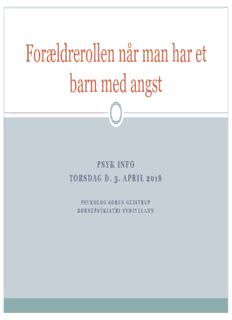
Børn og angst
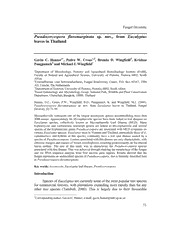
Pseudocercospora flavomarginata sp. nov. from Eucalyptus leaves in Thailand
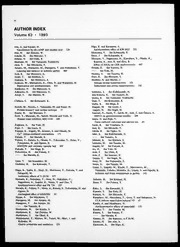
Japanese Journal of Pharmacology 1993: Vol 63 Index

PR - Связь с общественностью. Хрестоматия
![Algebraische Strukturen [Lecture notes] book image](https://cdn.pdfdrive.to/media/content/thumbnails/0075a463-535e-4eda-ad56-e43eea31d595.webp)
Algebraische Strukturen [Lecture notes]
